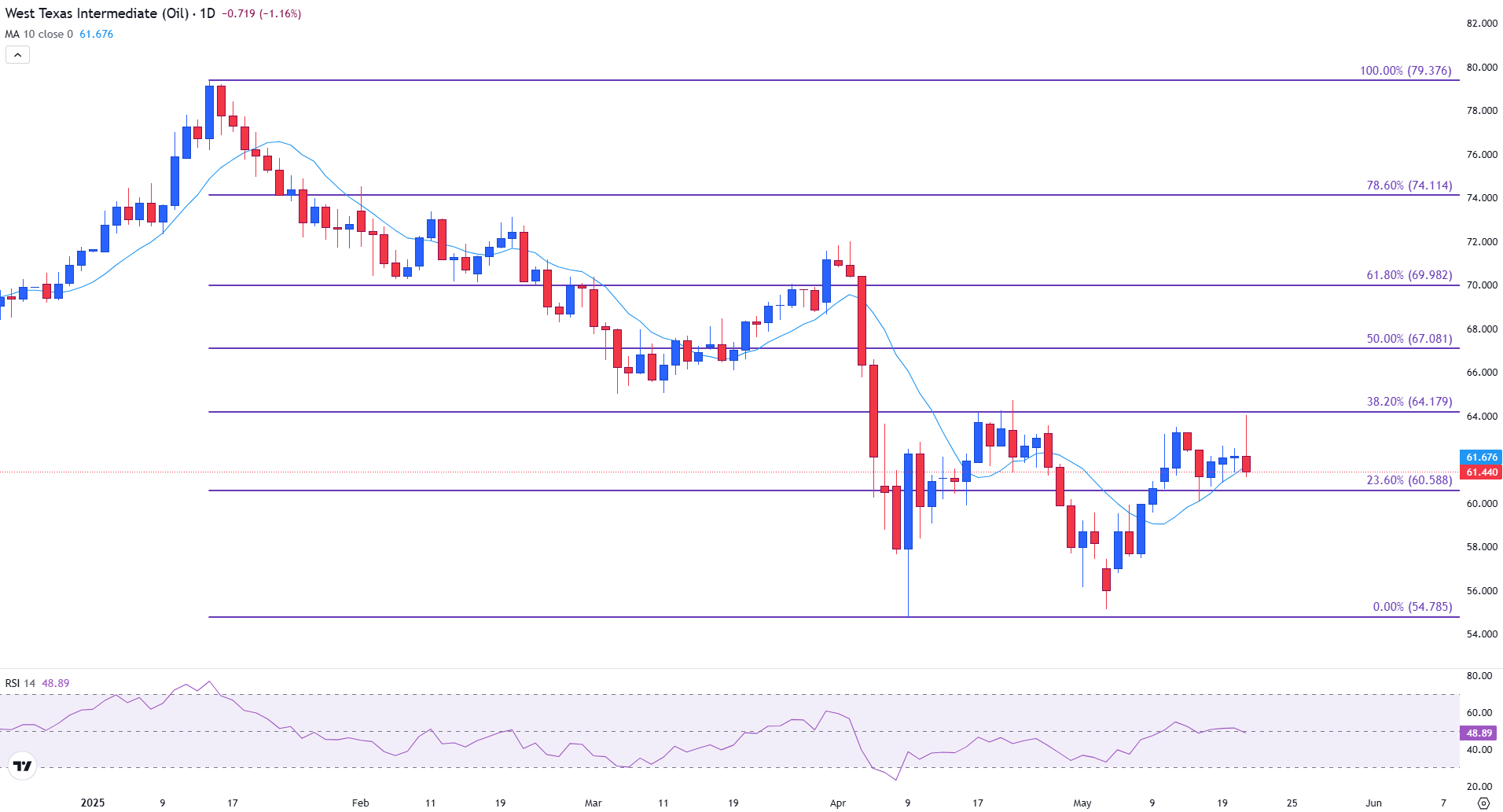- WTI crude oil rides below $ 62.00.
- The EIA report highlights an increase in offer, exerting downward pressure on prices.
- Geopolitical risks, including nuclear conversations between the US and Iran, remain a key focal point for oil prices.
Oil prices have been under persistent pressure since the inauguration of the president of the United States (USA), Donald Trump, in January, affected by a combination of fears of recession, increased global offer and a weaker US dollar.
These factors have collectively contributed to a new weakness in the liquid raw material, attenuating the bullish impulse that previously supported high energy prices.
For crude oil West Texas Intermediate (WTI)-the American reference extracted mainly from Texas and surrounding regions-prices found support at the end of last year as global trade resumed and post-pandemic demand increased.
This resurgence helped raise energy prices during the last months of last year, particularly as the offer remained restricted.
However, under the administration of Trump, new energy policy priorities, including proposals to expand national oil production and relieve environmental regulations, market expectations have changed on long -term offer growth. These developments, together with the persistent macroeconomic uncertainty and slow growth in the main economies, have altered the general perspective of supply and demand towards mid -2025.
Adding downward pressure on crude oil, new data from the US Energy Information Administration (EIA) revealed an increase in expected in domestic oil inventories, pointing out a possible weakness in demand and reinforcing concerns about excess supply.
The increase in inventories occurs in the midst of continuous production increases by non -OPEC players, including those of the US schista and OPEP+, which recently confirmed plans to increase production to defend their market share. These pressures on the offer have weighed even more about the WTI, which now quotes below $ 62 per barrel.
Despite the known risks surrounding the oil market, including sensitivity to inflation and fiscal effects, geopolitical developments remain a key wild card.
On Wednesday, reports arose that Israel could be preparing possible attacks on Iranian nuclear facilities, briefly pushing rising prices before the profits faded behind the inventory bearish data. The possibility of an escalation in the Middle East could reintroduce risk premiums, particularly if supply routes are interrupted, although for now, the market seems more focused on structural imbalances.
The WTI rally runs out of fuel below $ 62.00
From a technical point of view, the crude WTI recently tried to break above the level of fibonacci recoil of 38.2% ($ 64,179) of the accumulated fall from January to April.
However, the rally was limited by strong sales pressure, forming a long superior wick in the daily candle, a classic sign of bullish exhaustion and a possible reversal point.
This reinforces the region of $ 64.00 as a key resistance, less than buyers can recover control above this level, short -term price action could favor greater consolidation or downward movement.
The simple mobile average (SMA) of 10 days about $ 61,68 is acting as a dynamic support, while a clear downward break could expose the following support zone at 60.58 $ (23.6% FIB).
WTI crude oil daily graphics

(This story was corrected on May 21 at 20:38 GMT to say in the head
WTI FAQS oil
WTI oil is a type of crude oil that is sold in international markets. WTI are the acronym of West Texas Intermediate, one of the three main types that include the Brent and Dubai’s crude. The WTI is also known as “light” and “sweet” by its relatively low gravity and sulfur content, respectively. It is considered high quality oil that is easily refined. It is obtained in the United States and is distributed through the Cushing Center, considered “the crossing of the world.” It is a reference for the oil market and the price of WTI is frequently traded in the media.
Like all assets, supply and demand are the main factors that determine the price of WTI oil. As such, global growth can be a driver of the increase in demand and vice versa in the case of weak global growth. Political instability, wars and sanctions can alter the offer and have an impact on prices. OPEC decisions, a group of large oil -producing countries, is another key price factor. The value of the US dollar influences the price of WTI crude oil, since oil is mainly traded in US dollars, so a weaker dollar can make oil more affordable and vice versa.
Weekly reports on oil inventories published by the American Petroleum Institute (API) and the Energy Information Agency (EIA) influence the price of WTI oil. Changes in inventories reflect the fluctuation of supply and demand. If the data show a decrease in inventories, it can indicate an increase in demand, which would raise the price of oil. An increase in inventories may reflect an increase in supply, which makes prices lower. The API report is published every Tuesday and that of the EIA the next day. Their results are usually similar, with a 1% difference between them 75% of the time. EIA data is considered more reliable, since it is a government agency.
The OPEC (Organization of Petroleum Exporting Countries) is a group of 13 nations oil producing that collectively decide the production quotas of member countries in biannual meetings. Their decisions usually influence WTI oil prices. When OPEC decides to reduce fees, it can restrict the supply and raise oil prices. When OPEC increases production, the opposite effect occurs. The OPEC+ is an expanded group that includes another ten non -members of the OPEC, among which Russia stands out.
Source: Fx Street
I am Joshua Winder, a senior-level journalist and editor at World Stock Market. I specialize in covering news related to the stock market and economic trends. With more than 8 years of experience in this field, I have become an expert in financial reporting.







